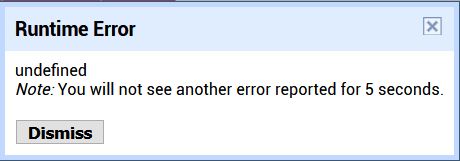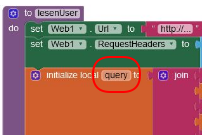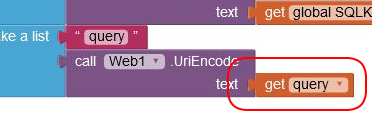Hallo,
folgendes funktioniert:
Warum funktioniert die folgende Variante nicht?
Es kommt der Fehler

Leider ohne weitere Informationen.
Hallo,
folgendes funktioniert:
Warum funktioniert die folgende Variante nicht?
Es kommt der Fehler

Leider ohne weitere Informationen.
put your web1.url and web1.requestheaders blocks inside the local variable block.
Leider derselbe Fehler.
Just in case it is a copy and paste error, change the name of query for the local variable:

does it change here as well:

Ja auch das get query hat sich geändert, aber ohne Erfolg.
Wenn ich "initialize local query" weglase und stattdessen den join einer Textbox zuweise und diese im call Web1 angebe, funktioniert es.
Ebenso funktioniert es, wenn ich query als globale Variable definiere.
Warum es aber in der mit der "initialize local"-Version nicht funktioniert, ist äusserst seltsam, isn'it?
are you using a correct url for your query?
what happens, if you try this
\n necessary in your query... I'm actually wondering, that this is working... I would replace \n by an empty text (Leerzeichen  )
)\n scheint kein Problem zu sein. Im Beispiel von Pura Vida:
SELECT * FROM employer \nWHERE lng > 175 and lng < 176 \n and lat < -37.710 and lat > -38.00
My suspicion is that \n is really the culprit, text join does sometimes strange things with it.
But without something to try (I am not going to try and recreate your app), it is hard to say.
To find out, you can do some debugging of course, like putting temporarily an extra label in your app that shows what the local query variable is, as opposed what a global variable has.
Why not do it like Taifun has done in the tutorial:
I believe the use of the "\n" in the tutorial was for display purposes in the screenshots. There is no use of "\n" in the queries shown in the tutorial blocks.
The query, as I am sure you know, should look like this:
SELECT * FROM <tabName> WHERE user="<user>"
Zur Info:
An dem "\n" kann es nicht liegen, da der Effekt auch auftritt, wenn ich es durch ein " " ersetze